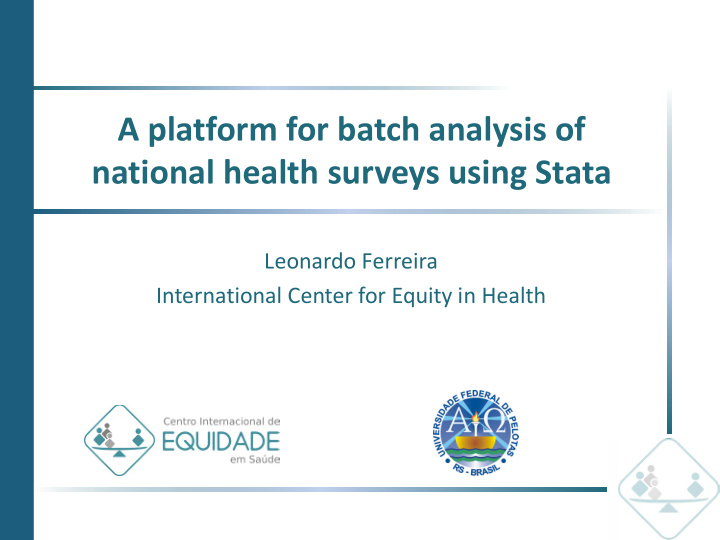



A platform for batch analysis of national health surveys using Stata Leonardo Ferreira International Center for Equity in Health
Introduction - Activities of the ICEH - Background - Stages of the analysis - Codes in Stata - The equiplot graph
ICEH overview - The International Center for Equity in Health (ICEH) produces standardized and disaggregated results from household surveys - Database with over 300 surveys representing over 100 countries - Focus in RMNCH in low-and-middle income countries (LMIC) - Delivers data to international partners such as WHO, UNICEF and World Bank.
Indicators and stratifiers Indicators Stratifiers - Contraceptive rate - Wealth - Measles vaccine - Sex of the child - Exclusively breastfed - Urban/rural zone children - Maternal education - Access to improved - Maternal age drinking water - Geographical region - ..over 50 indicators
Surveys - Main data sources: - Demographic and Health Surveys (DHS) - Multiple Indicator Cluster Survey (MICS). - Secondary data sources: - Reproductive and Health Surveys (RHS) - National surveys The surveys are more or less standardized!
SDG target for equity “to increase significantly the availability of high-quality, timely and reliable data disaggregated by income, gender, age, race, ethnicity, migratory status, disability, geographic location and 17.18 Data, monitoring other characteristics relevant and accountability in national contexts.”
Why is the ICEH work important? - Able to analyse hundreds of surveys for several indicators and stratifiers - Standardized indicators allow: - Comparison among countries - Usage of global, regional and sub-national estimates - Flexibility to quickly analyse new indicators and/or stratifiers on demand
Data examples - contraception National estimates Wealth disaggregated estimates
Stages of the analysis Pre-analysis Analysis Post-analysis Stratify and Check against Create Control generate published indicators dataset and stratifiers outputs estimates
Control dataset
Obtaining control dataset information
Why do we need the control dataset? Same categories, different variables Same variables, different categories
Generating indicators
Anymissvar & allmissvar
Results in matrices
The equiplot - A graph developed by the ICEH to present inequalities in subgroups - Can be used to compare countries, interventions, or time trends. - Freely available at www.equidade.org
The equiplot U5MR in Bangladesh 4 interventions in by wealth quintiles Ethiopia by wealth
Thank you! Leonardo Ferreira lferreira@equidade.org International Center for Equity in Health www.equidade.org
Recommend
More recommend